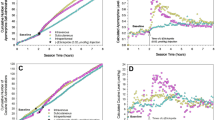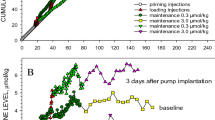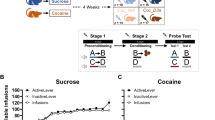Abstract
The sensitizing properties of drugs of abuse have been proposed to play an important role in the persistence of drug seeking behavior. We decided to evaluate the temporal relationship of dopamine D2 receptor-mediated drug seeking behavior and behavioral sensitization in animals with a history of cocaine and heroin self-administration. During early phases of withdrawal (<1 week), activation of dopamine D2 receptors with quinpirole resulted in robust, dose-dependent, reinstatement of (non-reinforced) responding in both cocaine- and heroin-trained rats. Cocaine and heroin seeking induced by quinpirole was associated with a dramatic enhancement of the psychomotor stimulant effects of the D2 agonist, indicating that sensitization to D2-mediated events had developed. During the late phase of withdrawal (>3 weeks), reinstatement of cocaine seeking by quinpirole was still apparent, but less robust. In heroin-trained rats, increases of responding were no longer observed. Interestingly, behavioral sensitization to quinpirole was still observed in cocaine-trained rats, but was absent in heroin-trained rats. Thus, it appears that dopamine D2 receptors have a time-dependent role in relapse to cocaine and heroin seeking which is strongly associated with a behaviorally sensitized state.
Similar content being viewed by others
Log in or create a free account to read this content
Gain free access to this article, as well as selected content from this journal and more on nature.com
or
References
Bonhomme N, Cador M, Stinus L, Le Moal M, Spampinato U . (1995): Short and long-term changes in dopamine and serotonin receptor-binding sites in amphetamine-sensitized rats—a quantitative autoradiographic study. Brain Res 675: 215–223
Cornish JL, Kalivas PW . (2000): Glutamate transmission in the nucleus accumbens mediates relapse in cocaine addiction. J Neurosci 20: U11–U15
De Boer P, Enrico P, Wright J, Wise LD, Timmerman W, Moor E, Dijkstra D, Wikstrom HV, Westerink BHC . (1997): Characterization of the effect of dopamine D3 receptor stimulation on locomotion and striatal dopamine levels. Brain Res 758: 83–91
De Vries TJ, Schoffelmeer ANM, Binnekade R, Mulder AH, Vanderschuren LJMJ . (1998a): MK-801 reinstates drug-seeking behaviour in cocaine-trained rats. Neuroreport 9: 637–640
De Vries TJ, Schoffelmeer ANM, Binnekade R, Mulder AH, Vanderschuren LJMJ . (1998b): Drug-induced reinstatement of heroin- and cocaine-seeking behaviour following long-term extinction is associated with expression of behavioural sensitization. Eur J Neurosci 10: 3565–3571
De Vries TJ, Schoffelmeer ANM, Binnekade R, Vanderschuren LJMJ . (1999): Dopaminergic mechanisms mediating the incentive to seek cocaine and heroin following long-term withdrawal of IV drug self-administration. Psychopharmacol 143: 254–260
De Wit H . (1996): Priming effects with drugs and other reinforcers. Exp Clin Psychopharmacol 4: 5–10
Deroche V, Le Moal M, Piazza PV . (1999): Cocaine self-administration increases the incentive motivational properties of the drug in rats. Eur J Neurosci 11: 2731–2736
Druhan JP, Walters CL, Aston-Jones G . (2000): Behavioral activation induced by D2-like receptor stimulation during opiate withdrawal. J Pharmacol Exp Ther 294: 531–538
Everitt BJ, Parkinson JA, Olmstead MC, Arroyo M, Robledo P, Robbins TW . (1999): Associative processes in addiction and reward—The role of amygdala-ventral striatal subsystems. Ann NY Acad Sci 877: 412–438
Henry DJ, White FJ . (1991): Repeated cocaine administration causes persistent enhancement of D1 dopamine receptor sensitivity within the rat nucleus accumbens. J Pharmacol Exp Ther 258: 882–890
Jaffe JH, Cascella NG, Kumor KM, Sherer MA . (1989): Cocaine-induced cocaine craving. Psychopharmacol 97: 59–64
Kalivas PW, Duffy P . (1993): Time course of extracellular dopamine and behavioral sensitization to cocaine. I. Dopamine axon terminals. J Neurosci 13: 266–275
Katner SN, Magalong JG, Weiss F . (1999): Reinstatement of alcohol-seeking behavior by drug-associated discriminative stimuli after prolonged extinction in the rat. Neuropsychopharmacol 20: 471–479
Khroyan TV, Barrett-Larimore RL, Rowlett JK, Spealman RD . (2000): Dopamine D1-and D2-like receptor mechanisms in relapse to cocaine-seeking behavior: effects of selective antagonists and agonists. J Pharmacol Exp Ther 294: 680–687
King GR, Ellinwood EH, Silvia C, Joyner CM, Xue Z, Caron MG, Lee TH . (1994): Withdrawal from continuous or intermittent cocaine administration—Changes in D-2 receptor function. J Pharmacol Exp Ther 269: 743–749
Koob GF . (1992): Drugs of abuse: anatomy, pharmacology and function of reward pathways. Tr Pharmacol Sci 13: 177–184
Kosten TR, Rounsaville BJ, Kleber HD . (1986): A 2.5-year follow-up of depressions, life crises, and treatment effects on abstinence among opioid addicts. Arch Gen Psych 43: 733–739
Lachowicz JE, Sibley DR . (1997): Molecular characteristics of mammalian dopamine receptors. Pharmacol Toxicol 81: 105–113
Ludwig AM, Wikler A, Stark LH . (1974): The first drink: psychobiological aspects of craving. Arch Gen Psych 30: 539–547
McFall ME, Mackay PW, Donovan DM . (1992): Combat-related posttraumatic-stress-disorder and severity of substance-abuse in Vietnam veterans. J Stud Alcohol 53: 357–363
McFarland K, Ettenberg A . (1997): Reinstatement of drug-seeking behavior produced by heroin-predictive environmental stimuli. Psychopharmacol 131: 86–92
Meyer RE, Mirin SM . (1979): The heroin stimulus: implications for a theory of addiction. New York, Plenum Medical Book Company
Neisewander JL, O'Dell LE, Tran-Nguyen LT, Castaneda E, Fuchs RA . (1996): Dopamine overflow in the nucleus accumbens during extinction and reinstatement of cocaine self-administration behavior. Neuropsychopharmacol 15: 506–514
Nestby P, Schotte A, Janssen PM, Tjon GKH, Vanderschuren LJMJ, De Vries TJ, Mulder AH, Leysen JE, Schoffelmeer ANM . (1997): Striatal dopamine receptors in rats displaying long-term behavioural sensitization to morphine. Synapse 27: 262–265
O'Doherty F, Davies BJ . (1987): Life events and addiction: A critical review. Br J Addict 82: 127–137
Paulson PE, Robinson TE . (1995): Amphetamine-induced time-dependent sensitization of dopamine neurotransmission in the dorsal and ventral striatum—a microdialysis study in behaving rats. Synapse 19: 56–65
Pugsley TA, Davis MD, Akunne HC, Mackenzie RG, Shih YH, Damsma G, Wikstrom H, Whetzel SZ, Georgic LM, Cooke LW, Demattos SB, Corbin AE, Glase SA, Wise LD, Dijkstra D, Heffner TG . (1995): Neurochemical and functional characterization of the preferentially selective dopamine D3 agonist PD 128907. J Pharmacol Exp Ther 275: 1355–1366
Robinson TE, Berridge KC . (1993): The neural basis of drug craving: an incentive-sensitization theory of addiction. Brain Res Rev 18: 247–291
Rossetti ZL, Hmaidan Y, Gessa GL . (1992): Marked inhibition of mesolimbic dopamine release—a common feature of ethanol, morphine, cocaine and amphetamine abstinence in rats. Eur J Pharmacol. 221: 227–234
Self DW, Barnhart WJ, Lehman DA, Nestler EJ . (1996): Opposite modulation of cocaine-seeking behavior by D1- and D2-like dopamine receptor agonists. Science 271: 1586–1589
Self DW, Nestler EJ . (1998): Relapse to drug-seeking: neural and molecular mechanisms. Drug Alcohol Dependence 51: 49–60
Shaham Y, Erb S, Stewart J . (2000): Stress-induced relapse to heroin and cocaine seeking in rats: a review. Brain Res Rev 33: 13–33
Shaham Y, Rajabi H, Stewart J . (1996): Relapse to heroin-seeking in rats under opioid maintenance: the effects of stress, heroin priming, and withdrawal. J Neurosci 16: 1957–1963
Shaham Y, Rodaros D, Stewart J . (1994): Reinstatement of heroin-reinforced behavior following long-term extinction—implications for the treatment of relapse to drug taking. Behav Pharmacol 5: 360–364
Shaham Y, Stewart J . (1995): Stress reinstates heroin-seeking in drug free animals—an effect mimicking heroin, not withdrawal. Psychopharmacol 119: 334–341
Stewart J . (1984): Reinstatement of heroin and cocaine self-administration behavior in the rat by intracerebral application of morphine in the ventral tegmental area. Pharmacol Biochem Behav 20: 917–923
Stewart J, Vezina P . (1988): A comparison of the effects of intra-accumbens injections of amphetamine and morphine on reinstatement of heroin intravenous self-administration behavior. Brain Res 457: 287–294
Tjon GHK, De Vries TJ, Ronken E, Hogenboom F, Wardeh G, Mulder AH, Schoffelmeer ANM . (1994): Repeated and chronic morphine administration causes differential long-lasting changes in dopaminergic neurotransmission in rat striatum without changing its delta- and kappa-opioid receptor regulation. Eur J Pharmacol 252: 205–212
Tran-Nguyen LL, Fuchs RA, Coffey GP, Baker DA, O'Dell LE, Neisewander JL . (1998): Time-dependent changes in cocaine-seeking behavior and extracellular dopamine levels in the amygdala during cocaine withdrawal. Neuropsychopharmacol 19: 48–59
Ujike H, Akiyama K, Otsuki S . (1990): D-2 but not D-1 dopamine agonists produce augmented behavioral-response in rats after subchronic treatment with methamphetamine or cocaine. Psychopharmacol 102: 459–464
Unterwald EM, Ho A, Rubenfeld JM, Kreek MJ . (1994): Time-course of the development of behavioral sensitization and dopamine-receptor up-regulation during binge cocaine administration. J Pharmacol Exp Ther 270: 1387–1396
Vallone D, Picetti R, Borrelli E . (2000): Structure and function of dopamine receptors. Neurosci Biobehav Rev 24: 125–132
Vanderschuren LJMJ, Schoffelmeer ANM, Mulder AH, De Vries TJ . (1999): Dopaminergic mechanisms mediating the long-term expression of locomotor sensitization following pre-exposure to morphine or amphetamine. Psychopharmacol 143: 244–253
Vanderschuren LJMJ, Kalivas PW . (2000): Alterations in dopaminergic and glutamatergic transmission in the induction and expression of behavioral sensitization: a critical review of preclinical studies. Psychopharmacol 151: 99–120
Weiss F, Maldonado-Vlaar CS, Parsons LH, Kerr TM, Smith DL, Ben-Shahar O . (2000): Control of cocaine-seeking behavior by drug-associated stimuli in rats: Effects on recovery of extinguished operant-responding and extracellular dopamine levels in amygdala and nucleus accumbens. Proc Natl Acad Sci USA 97: 4321–4326
Wise RA, Bozarth MA . (1987): A psychomotor stimulant theory of addiction. Psychol Rev 94: 469–492
Wise RA, Murray A, Bozarth MA . (1990): Bromocriptine self-administration and bromocriptine- reinstatement of cocaine-trained and heroin-trained lever pressing in rats. Psychopharmacol 100: 355–360
Wolf ME, White FJ, Nassar R, Brooderson RJ, Khansa MR . (1993): Differential development of autoreceptor subsensitivity and enhanced dopamine release during amphetamine sensitization. J Pharmacol Exp Ther 264: 249–255
Acknowledgements
The authors wish to thank Dr. L. van Wolfswinkel for providing additional software used for data analysis.
Author information
Authors and Affiliations
Corresponding author
Rights and permissions
About this article
Cite this article
De Vries, T., Schoffelmeer, A., Binnekade, R. et al. Relapse to Cocaine- and Heroin-Seeking Behavior Mediated by Dopamine D2 Receptors Is Time-Dependent and Associated with Behavioral Sensitization. Neuropsychopharmacol 26, 18–26 (2002). https://doi.org/10.1016/S0893-133X(01)00293-7
Received:
Revised:
Accepted:
Published:
Issue date:
DOI: https://doi.org/10.1016/S0893-133X(01)00293-7
Keywords
This article is cited by
-
Neuroprotective effects of quinpirole on lithium chloride pilocarpine-induced epilepsy in rats and its underlying mechanisms
European Journal of Medical Research (2024)
-
Effect of the dopamine stabilizer (-)-OSU6162 on potentiated incubation of opioid craving after electric barrier-induced voluntary abstinence
Neuropsychopharmacology (2020)
-
Relapse to opioid seeking in rat models: behavior, pharmacology and circuits
Neuropsychopharmacology (2019)
-
Role of dopamine D2-like receptors and their modulation by adenosine receptor stimulation in the reinstatement of methamphetamine seeking
Psychopharmacology (2019)
-
Effects of pramipexole on the acquisition of responding with opioid-conditioned reinforcement in the rat
Psychopharmacology (2015)



